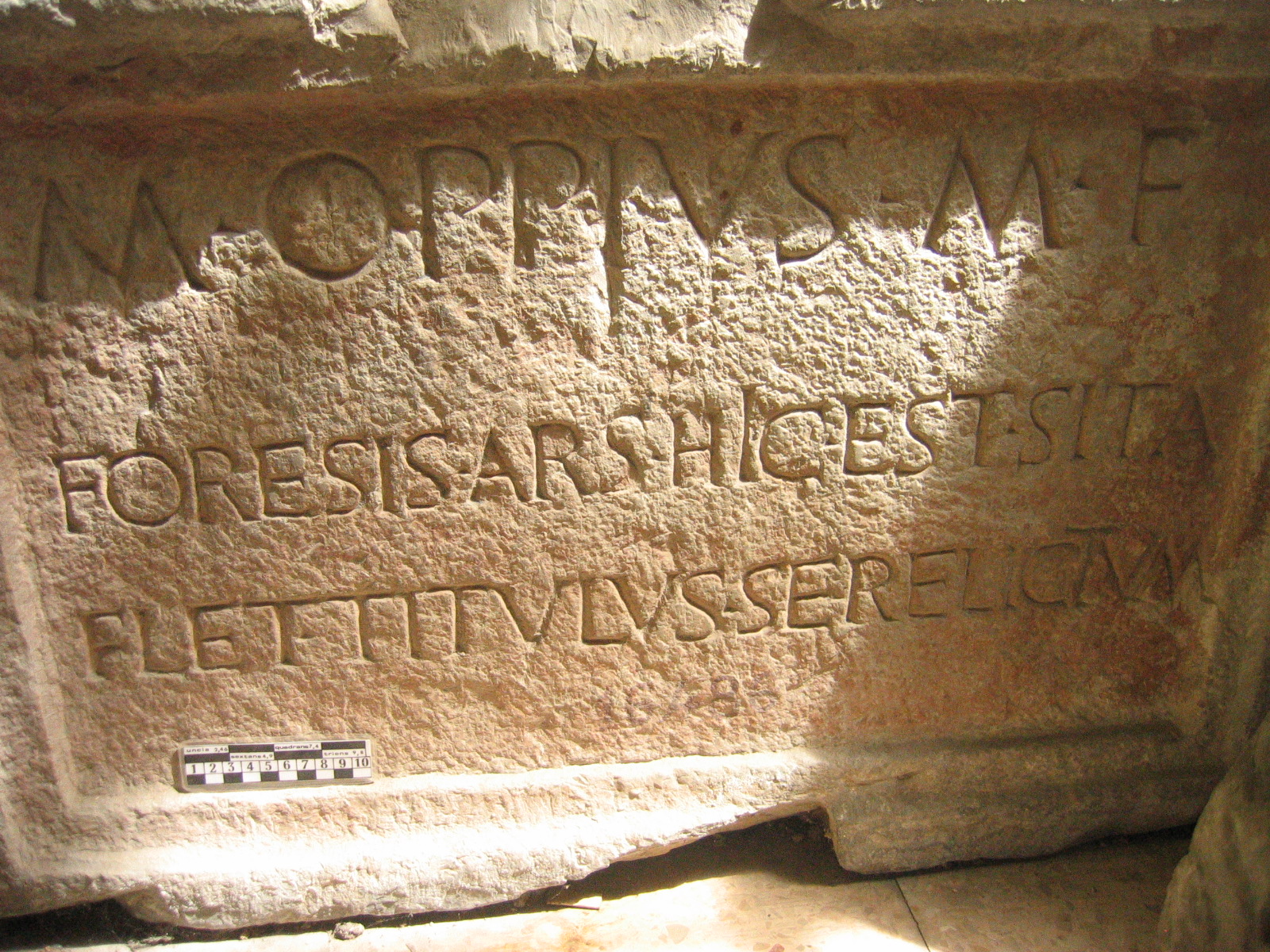(Español) MU13C Epitafio del abogado M. Oppius
Reference CIL II 3493, cf. p. 952; ad CLE 224 | Description | Lyrics | Location | Chronology | Epigraphic edition | Translation | Apparatus | Comentary | Type of verse | Text divided into verses and metric signs | Images | Bibliography | Link to DB | Author |
Description
- Idno filename 22/02/0083
- Type of inscription: Sepulcralis
- Support: Placa
- Material: Caliza Material Description: Color gris.
- Conservation status: Presenta roturas que no afectan al texto. La cara anterior y la izquierda están alisadas; las demás, desbastadas.
- Dimensions height/width/depth (cm): 54/80/19
-
Epigraphic field:
- Layout: El campo epigráfico está rebajado y enmarcado por una moldura. Interpunción triangular.
- Conservada
Lyrics
- Font:Capital cuadrada
- Letter size:(l. 1) 6, (ll. 2-3) 4 cm
- Description of the letters:I "longa" (l. 2). T "summa" (l. 3: "relictum").
Location
- Place of discovery: Hallada en Cartagena.
- Geolocation
- Conservation location: Se conserva en el M.A.N.
- Inventory number: 16.486
- Location with Modern Nomenclature España / Murcia / Cartagena
- Location with Old Nomenclature Hispania / Citerior / Carthaginensis / Carthago Nova
Chronology
- Inscription's dating: Between year 1 and year 30
- Dating explanation: La ausencia de cognomen es indicio de antigüedad. Por las características gráficas y paleográficas, puede datarse como de la época de Augusto.
Type of verse
- Type of verse: Yámbico (septenario)
- Verse/line correspondence: No
- Prose/verse distinction: Si
Epigraphic edition
M(arcus) ▴ Oppius ▴ M(arci) ▴ f(ilius)
Fore(n)sis ▴ ars ▴ híc ▴ est ▴ sita
flet ▴ titulus ▴ se ▴ relictum
Text divided into verses and metric signs
Forensis ars hic est sita, flet titulus se relictum. kl|kl|ll|kl||lkk|ll|kl|~
Bibliography
Hübner II 3493, cum indice librorum antiquiorum, add. p. 952 (inde Bücheler, ad CLE 224; Cholodniak 1904, 1186; Beltrán Martínez 1950, 417 n. 74; Hernández Pérez 1997, 97–103, cum im. phot. [AE 1997, 948]); Abascal – Ramallo 1997, n. 161, cum im. phot.; Gómez Font – Hernández Pérez 2006, n. 6, cum im. phot.; Cugusi 2012, 88. – Cf. Mariner 1952, 149; Hernández Pérez 2001a, 194–195; Massaro 2001, 308–310; Cugusi 2007, 100.
Comentary
La grafía foresis en vez de forensis refleja la pronunciación corriente: el propio Cicerón, según el testimonio de Velio Longo (Gramm. Lat. Keil VII 79,1 s.), pronunciaba foresia et Megalesia et hortesia sine n littera.
2 Fore(n)sis ars hic est sita: elogio hiperbólico como el de los presuntos autoepitafios de Nevio y de Plauto (apud Gell. 1,24,2-3); cf. también Mart. 11,13,3-7; Anth. Pal. 7,562,6. – 3 titulus: scil. fore(n)sis; flet titulus, como comoedia luget en el citado autoepitafio de Plauto. Puede distinguirse un septenario yámbico: Foresis ars hic est sita, | flet titulus se relictum.
Author
- Author:R. Hernández Pérez, X. Gómez Font
- Last Update2023-03-31 10:26:49
- Autopsy date:2002
You can download this






